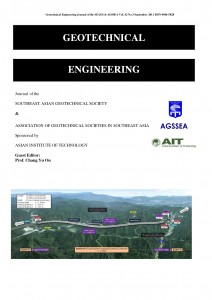Three-Dimensional Deformation Behavior of an Over-sized Excavation in Shanghai Clay
Main Article Content
Abstract
In this paper, a case study regarding the excavation of the largest excavation in Shanghai soft clays (Zhongsheng Shopping Mall) is investigated through field studies and numerical modelling. To reduce the excavation induced deformation and construction time, a combination of excavation support schemes, the central part by bottom-up method and the peripheral part by top-down method, is used in this construction project. Extensive field performance data, including wall deflections and ground surface settlements, were collected. Construction sequences are summarized and correlated with the measured data. Three-dimensional effective stress elasto-plastic finite element analysis is conducted to examine the wall deflections and ground surface movements. A comprehensive comparison with the field observations has demonstrated the capacity of numerical models for the predictions of wall deflections and ground surface settlements. Numerical studies indicate that both the wall deflection and ground surface settlement are affected by the excavation corner as well as the length and the shape of the wall. Parametric studies of two construction sequences reveal that the deformations of the wall and soil are larger due to the circumstance that some supports are not installed in time during excavation. Zone excavation exerts a slight effect on the wall deflection for the wall panels near the centers of the excavated zones, but causes less wall deflection for the wall panels near the corners of the excavated zones.
Article Details

This work is licensed under a Creative Commons Attribution-NonCommercial-NoDerivatives 4.0 International License.
Copyright © 2019 Association of Geotechnical Societies in Southeast Asia (AGSSEA) - Southeast Asian Geotechnical Society (SEAGS).


